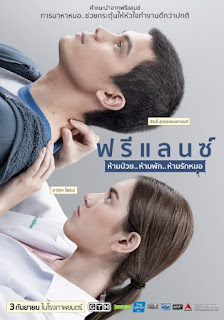The autumn film festival season is upon us, with Thai films highlighted in Busan, Tokyo and Taipei. I also have an item from late in the summer, of an award in Rio.
The Busan International Film Festival gets underway on Thursday, paying tribute to the masters of Asian cinema.
Apichatpong Weerasethakul will of course be taking part in that. He's among the festival's "Top 10 directors" and was also among the experts polled for the fest's "Asian Cinema 100", listing the 100 best Asian films of all time. The top 10 (actually 11) will screen at the fest.
And Apichatpong's latest feature, Cemetery of Splendour will screen at Busan as part of the Window on Asian Cinema. Splendour has been on a tear since taking the Cannes Film Festival by storm back in May, recently playing in Toronto and in New York.
Apichatpong also contributed to a new collection of short films for the Busan fest, Color of Asia – Masters, along with Naomi Kawase, Wang Xiaoshuai and Im Sang-soo. Apichatpong's short is called Vapour, "a lyrical piece absent of any dialogue". There's a trailer embedded below.
Busan also highlights newer talents with another shorts compilation, Color of Asia – Newcomers. Up-and-coming indie filmmaker Phuttiphong Aroonpheng is behind the segment titled Ferris Wheel, about a migrant-worker mother and her son attending a rural carnival and encountering a creepy stranger in a monkey costume. Again, there's a trailer for that one, and it's embedded below.
Beyond Splendour and the short films, Busan also has a couple of Thai documentaries. There is Nawapol Thamrongrattanarit's talking-head parade The Master, which has Thai film luminaries reminiscing about Mr. Van, the guy who briefly ruled Bangkok's pirate-movie scene in the days before bittorrent. It was shopped at last year's Asian Project Market.
Aditya Assarat also looks into the Thai movie-going scene with The Scala, a 52-minute piece about Bangkok's endangered landmark Scala cinema. The link on the BIFF website sent me in a circle back to the homepage, so I turned to the director for help. He provided me with a PDF that details the Power of Asian Cinema project of the Korean Broadcast System and the Busan fest, which brought together 10 Asian directors to make documentaries for South Korean TV. All 10 will be shown during the festival. Aditya's short recalls his memories of the Scala. Here's the synopsis:
I always like to watch movies at The Scala. It reminds me of my childhood when all the cinemas in Bangkok were standalone cinemas. At the time, I never thought it was anything special. But now that I am older, I have become nostalgic. There are many things about it I wanted to document: the staff, who are all old now, the space, which is very beautiful, and the ideal, of movie-watching as a special event. In a way, The Scala is similar to all of us who persevere, despite the difficulties, to celebrate cinema in the way we remember it to be.
The Scala opened its doors in 1970. It had one thousand seats and every night, they were filled. In those days, going to the movies was something special. The cinema was a place where people got dressed up, went on dates, and fell in love. But today, everything has changed. There is a multiplex in every mall and the young generation watch movies on their phone. But at The Scala, time has stood still. The cinema is still run by many of the same staff who have been there from the beginning. It is now the last remaining standalone cinema left in Bangkok. And soon, its time will come to an end too.
Next up is the Tokyo International Film Festival, which has two world premieres of Thai films, Kongdej Jaturanrasamee's Snap and Pimpaka Towira's The Island Funeral (มหาสมุทรและสุสาน, Maha Samut Lae Susaan).
Part of Tokyo fest's main competition, Snap is a romantic drama produced by TrueVisions and is set against a period of martial law in Thailand. It stars newcomer actress Waruntorn Paonil as a young woman returning to her hometown for a friend's wedding. The wedding photographer (Toni Rakkaen) turns out to be a young man from her past.
Pimpaka's long-awaited second dramatic feature The Island Funeral is in the Asian Future program. A road drama, it features a screenplay by film critic and documentary filmmaker Kong Rithdee. Check out the trailer, embedded below.
Moving on to Taipei, there's the Golden Horse International Film Festival, which will open with Distance, an omnibus feature put together by Singapore's Anthony Chen, who made the Cannes' Camera d'Or winner Ilo Ilo. According to The Hollywood Reporter, Distance stars Taiwanese actors Chen Bolin and Yo Yang alongside Hong Kong star Paul Chun. "The experimental drama sees Chen play three separate roles in each of three stories, separately helmed by Xin Yukun, Tan Shijie and Sivaroj Kongsakul. The directors hail, respectively, from China, Singapore and Thailand."
Sivaroj is the maker of tear-jerking sentimental short films as well as the emotional drama Tee Rak (Eternity), which was a prize-winner at Rotterdam and other fests.
Finally, here's some award news, which a reader gave me a tip on – Night Watch, a short film by Danaya Chulphuthiphong won the Special Jury Prize at the Fronteira Festival in Rio de Janeiro in August. According to a review, the experimental short takes place during a coup d'etat and the unrest that accompanies it, as seen from scenes on the streets and through television images. Danaya previously served as a cinematographer on Endless, Nameless, which was the top-prize winner at last year's Thai Short Film and Video Festival..
And so ends my second "Festival festival!" round-up of festival news. Thai filmmakers, if you have film in an upcoming festival or won an award somewhere, please feel free to let me know.





























